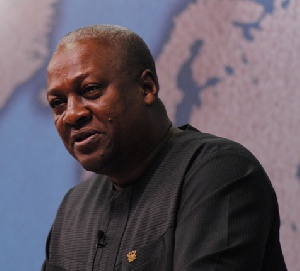As the 2024 election approaches, the National Democratic Congress (NDC) is hopeful of returning to power. Their flagbearer, John Dramani Mahama, is aggressively campaigning on several promises, including a pledge to use artificial intelligence (AI) to tackle unlawful small-scale mining.
According to Mahama, AI is the best technology for addressing this issue. However, it is critical to assess the feasibility and viability of this proposal.
During the 2020 election campaign, the NDC attempted to make the New Patriotic Party (NPP) unpopular in galamsey regions by promising miners that they would be able to continue working if the NDC won power. They denounced the NPP's activities against Galamsey, which helped them gain support in these areas. President Akuffo Addo's strategy for fighting galamsey was more forceful, resulting in the destruction of excavators and the seizure of assets worth millions of cedis. Additionally, military and police troops were dispatched to crack down on small-scale miners.
Ghana continues to grapple with the galamsey issue. Small-scale mining has destroyed inland water bodies and caused significant land degradation, which is disturbing. Persistent activities in galamsey areas have caused significant harm to farmlands and rivers. If the situation is not handled, the country's forests and water bodies may face major threats to their sustainability. This spurred the NPP government to take action to eliminate the prevalent practice. However, with increased unemployment and high living costs, many people rely on galamsey for a living.
In this setting, every government must enact policies that allow for small-scale mining while maintaining environmental sustainability. Mahama’s suggestion to deploy AI to fight galamsey is a step in this direction. However, he should address the bigger challenges that affect individuals who rely on galamsey for a living.
The Akufo-Addo government employed drones and human resources to monitor and prevent illegal mining, but the issue remains unresolved. The problem of galamsey stretches beyond the capacity of AI technology, and Mahama may not completely appreciate its limitations. While AI can map and evaluate degraded regions, Geographic Information System (GIS) technology is more advanced and commonly used for environmental mapping and analysis. Currently, there is no known AI application dedicated only to environmental mapping and analysis; however, AI can improve GIS performance.
While technology has an impact, it cannot address the galamsey problem, as Mahama claims. He needs to consult deeply and come up with a more realistic proposal that would appeal to the general populace. When people believe their livelihood is at stake, they will fight for change. Given Mahama's previous commitment in 2020 that mining would continue, it will be difficult for him to modify his position.
The emphasis should be on efforts that ensure people's livelihoods while also protecting the environment. AI will merely map and evaluate damaged areas, leaving the question of how to act on the findings unresolved. Mahama must think boldly and thoroughly to adequately address this complicated challenge, or else he is only promising in vain.
Opinions of Sunday, 19 May 2024
Columnist: Isaac Ofori







![NPP Flagbearer, Dr. Mahamudu Bawumia [L] and NDC Flagbearer John Mahama NPP Flagbearer, Dr. Mahamudu Bawumia [L] and NDC Flagbearer John Mahama](https://cdn.ghanaweb.com/imagelib/pics/869/86902869.295.jpg)











